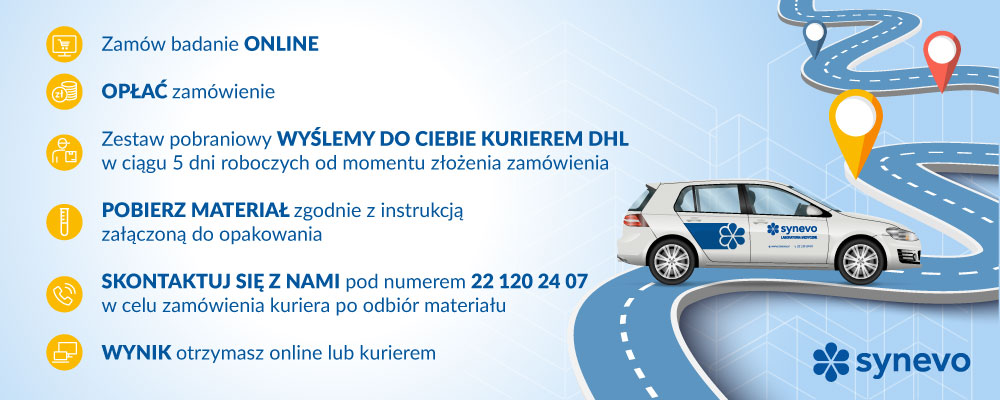Assessment of the genetic predispositions to thrombosis: mutations of the prothrombin gene (factor II) and Leiden (factor V)
Thrombosis is the third most common cardiovascular condition
in Poland, next to heart attack and stroke. Every year it is contracted by
approximately 60. thousand Poles. Carrying out the test will determine the predisposition
genetic predisposition to the disease, so that appropriate prophylaxis can be implemented
prevention. 
Available in stock
Fast turnaround time
Secure courier delivery
Convenience and comfort of shopping
Fast shipping
Directly from the manufacturer
Secure payments
Blik, Przelewy24

Genetic thrombosis test - convenient to perform, quick result
This test will allow you to quickly know your risk of developing thrombosis resulting from a genetic condition. Its purpose is to testing your genotype for Leiden mutations in the factor V gene and mutations in the factor II (prothrombin) gene. Mutations in these genes increase the risk of thrombosis by several times.
Doing the test will allow you to apply appropriate prophylaxis and, if necessary, start early treatment.
The risk of thrombosis is increased by a few factors
Main benefits of getting a thrombosis test:
- easy and convenient testing without leaving home
- the result is sent within 14 working days in the form of a paper through the Polish Post Office or electronically
- the result is sent to you in the form of a paper electronically
- You will receive the saliva sample self-sampling kit within 5 business days
- security and confidentiality of data
- guarantee of the highest quality standards of the test- service implemented by Nucleagen Laboratory, which has several years of experience in genetic testing, QCMD and INSTAND quality certificates.
For whom is genetic testing for predisposition to thrombosis?
In the increased risk group are people who:
- are taking oral contraceptives,
- are pregnant or planning a pregnancy,
- have an aggravating family history (occurrence of thrombosis in the family), such as repeated episodes of thrombosis in a close relative before the age of 50 years,
- have a history of thrombosis episodes, suffer from varicose veins or lead a sedentary lifestyle.
Persons in the risk group should conduct a genetic testing.

Genetic test material collection
The test is performed from a saliva sample taken as a swab from the buccal mucosa. It is necessary to read the instructions attached to the collection kit and carefully perform each point described therein point. The result of the test depends primarily on the quality and quantity of DNA in the collected material. Following the recommendations the attached instructions should ensure a correct result.
Information about the test
Aims and limitations of the study
The purpose of the test is to find genetic changes that may be responsible for the onset of a specific disease. Failure to find a genetic change genetic change does not mean that the disease cannot occur The likelihood of thrombosis is increased by: taking oral contraception, a sedentary lifestyle and an unhealthy diet.
Interpretation of a genetic test result depends on current medical knowledge, as well as a number of environmental and family conditions and family circumstances. Incomplete medical information regarding the patient or his or her family, including a different than declared relationship between the members of the family under study, can result in the results obtained tests will be misinterpreted.
Further medical decisions regarding the planned therapy, herein methods of disease prevention, should be based on a comprehensive assessment of the patient's health situation patient's health situation, and the obtained results of the genetic test supporting the decision-making process
Sampling
Genetic analysis is performed on the basis of a buccal swab buccal swab. Its results depend primarily on the quality and quantity of DNA in the collected material. It is necessary to strictly follow the rules of collection and follow the instructions included in the collection kit collection kit.
Notwithstanding adherence to laboratory standards, isolated material may not be in sufficient quantity or may undergo degraded (destroyed), making it impossible to perform the ordered genetic analysis. In such a case, it may be necessary to re-collection of material (swab from the mucous membrane of the inner side of the cheek). In such a situation, please contact Customer Customer Service, and we will send an additional collection kit free of charge.
